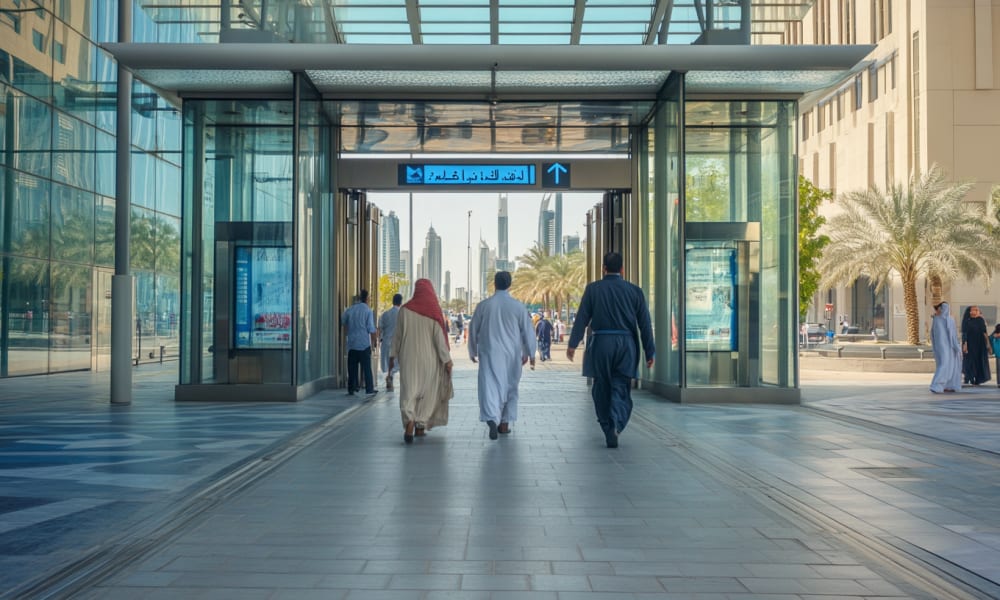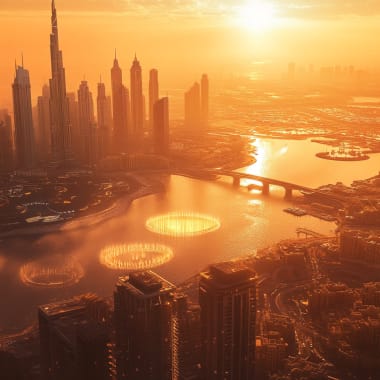
Transport options on site in Dubai
Whether for sightseeing, everyday life or luxury – Dubai's mobility system offers a well-thought-out experience for every requirement.
Whether for sightseeing, everyday life or luxury – Dubai's mobility system offers a well-thought-out experience for every requirement.
Dubai – A city of stylish mobility
In hardly any other city in the world do innovation, luxury, and efficiency in the field of mobility merge as impressively as in Dubai. Anyone traveling here experiences mobility not just as a necessity but as part of the overall urban experience – stylish, comfortable, and technologically at the highest level.
Dubai's reputation as a mobility metropolis is based on a state-of-the-art infrastructure and an impressive variety of transportation options. From the fully automated Dubai Metro to the elegant tram and the spectacular Palm Monorail to traditional abras on the creek – the city offers the right mode of transport for every type of journey. Comfort is a priority: air-conditioned stations, exclusive Gold Class compartments, and seamless connections between the most important hotspots are just some of the features that distinguish Dubai from other metropolises.
This article provides you with a comprehensive overview of the different transport options in Dubai – from the metro to the water taxi, from authentic experiences to luxurious alternatives. You will learn which routes are particularly worthwhile, how to find your way best, and what role culture, safety, and etiquette play in mobility. Welcome to a city where the journey itself becomes an experience.
- Overview of transport options in Dubai
- Water Taxis: Discover Dubai from the Water
- Practical Information on Ticket Options and Prices
- Alternative and Luxurious Transport Options in Dubai
- Cultural Influences and Infrastructure on the Choice of Transport
- Safety, Etiquette, and Practical Tips for Mobility
- Conclusion and Practical Tips for Travelers
Overview of transport options in Dubai
Dubai has an impressively versatile transportation network that ideally combines functionality, comfort, and tourist experiences. Whether you want to move efficiently through the city or enjoy spectacular views – Dubai's transport system offers the right solution for every requirement.
The Dubai Metro: Efficiency and Comfort Underground
The Dubai Metro is considered the heart of public transport. With its two lines – the red and the green – it covers central hubs such as the airport, the old town, the financial center, and the Expo site. Fully automated, air-conditioned, and designed to be barrier-free, it enables fast, clean, and affordable mobility – even for tourists. Rides along the Red Line, such as between the Dubai Mall and Dubai Marina, are particularly recommended, where one experiences a cross-section of the modern urban landscape.
The Dubai Tram: Seamless Integration into the Transport Network
The Dubai Tram connects the neighborhoods of Dubai Marina, Jumeirah Beach Residence, and Al Sufouh on approximately 11 kilometers. It is optimally linked with the metro and the Palm Monorail, ensuring seamless mobility between residential, leisure, and business districts. The tram operates at short intervals, is air-conditioned, and can also be used with the Nol Card – an example of Dubai's commitment to making mobility convenient and efficient.
Palm Jumeirah Monorail: A Scenic Ride
The Palm Jumeirah Monorail is much more than just a means of transport – it is also a small sightseeing tour. It runs between the Gateway Tower on the mainland and the famous Atlantis The Palm hotel at the tip of the artificial island. The elevated track offers impressive views of Dubai's skyline, the Arabian Gulf, and, of course, the iconic palm shape of the island. For tourists, the monorail is therefore a worthwhile introduction to the Dubai experience – stylish, comfortable, and with panoramic views.
Water Taxis: Discover Dubai from the Water
Water taxis offer a unique way to discover Dubai from a new perspective – stylish, relaxed, and with a direct view of some of the city’s most beautiful panoramas. They combine modern infrastructure with authentic experiences and turn every ride into a highlight.
Recommended Routes and Experiences
Especially worthwhile are rides along the Dubai Creek with traditional abras. For just 1 AED per trip, travelers experience the historical heart of the city, passing by souks, mosques, and old trading buildings. These short crossings between Deira and Bur Dubai are considered an authentic must-do for every visitor.
For those who prefer a more modern and comfortable experience, the air-conditioned water taxis from the RTA offer longer tours with impressive views of Dubai's skyline. Popular routes run along the coast from Dubai Marina past Atlantis The Palm to exclusive hotels like One&Only The Palm or Rixos. These rides can be booked individually and provide particularly spectacular photo opportunities at sunset or during the evening hours – ideal for a stylish city exploration on the water.
Practical Information on Ticket Options and Prices
For stress-free and flexible mobility in Dubai, it's worthwhile to take a closer look at the available ticket options and their pricing. Thanks to the unified payment system around the Nol Card, access to most public transport is simple and conveniently arranged – whether metro, bus, tram, or water bus.
Ticket Options for Public Transport
The centerpiece of the ticket and payment system in Dubai is the Nol Card. It is offered in four variants and can be used for almost all public transport. The Nol Red Ticket is a simple paper card for occasional riders, which can hold up to ten rides or five day passes. Particularly practical: day passes for all zones cost only 20 AED.
For frequent travelers, the Nol Silver Card is a better option. It is rechargeable, offers cheaper fares, and can be used flexibly. The Nol Gold Card is aimed at comfort-oriented passengers: it provides access to the luxurious Gold Class compartments of the metro and tram – but at higher prices. The Nol Personal Card is personalized and particularly suitable for frequent travelers with a long-term stay.
All cards are available and rechargeable at metro stations, in supermarkets like Carrefour or Spinneys, and through the RTA apps 'Nol Pay' and 'S’hail'. Contactless payment is made upon entry and exit. Particularly useful for tourists: the Red Ticket is ideal for short stays, while the Silver Card offers the best mix of price, comfort, and flexibility.
Price Comparison of Transport Options
The costs for public transport in Dubai are based on the number of zones passed through. Single rides start at 3 AED with the Silver Card (1 zone) and rise to 15 AED for longer distances in Gold Class. The Red Ticket is slightly more expensive per ride but offers an attractive option for intensive sightseeing days with the day pass.
In comparison, taxis start at around 6 AED base fare, with airport rides starting at 25 AED. The price per kilometer is about 2 AED, making shorter rides cost around 20 AED, while longer trips – such as from the airport to the center – can cost around 100 AED.
Those who primarily use the metro, bus, and tram will find the Silver Card to be the cheapest option. For special comfort, the Gold Card is worth it, while the Red Ticket serves as a simple entry solution for short visits. All cards are easy to handle and available at numerous sales points, making it particularly user-friendly to use the public transport network.
Alternative and Luxurious Transport Options in Dubai
In addition to the advanced public infrastructure, Dubai offers a variety of alternative and luxurious transportation options that provide both authentic insights and exclusive experiences. For travelers seeking something special – whether through cultural proximity or high comfort – suitable options are available.
Authentic Local Transport Options
Anyone wanting to experience Dubai in its original way should take a ride on a traditional abra. These open wooden boats operate on the Dubai Creek and connect neighborhoods like Deira and Bur Dubai – a short but intense insight into the historical life of the city. For just 1 AED per trip, the abra is not only extremely affordable but also an atmospheric experience that is appreciated by locals and tourists alike.
In addition, there are also special taxis with cultural references, such as the pink 'Ladies Taxis', which are exclusively operated by and for women. They not only provide a safe means of transport but also reflect local values and needs. These culturally adapted offerings illustrate how much Dubai strives to make mobility inclusive and accessible – without compromising on authenticity.
Luxurious Options for the Discerning Traveler
For discerning travelers, Dubai offers an impressive portfolio of luxurious means of transport. Limousine services with personal chauffeurs are included, as well as private helicopter transfers or exclusive yacht charters. Providers like Blacklane or Noble Transfer enable transfers in stylish limousines with professional support – perfect for business appointments or stylish arrivals. Prices start at around 350 AED and vary depending on the vehicle class, route, and extent of service.
A particularly impressive experience is helicopter flights over the city – bookable, among other things, through Uber or specialized providers. Short scenic flights over Palm Jumeirah, Burj Khalifa, or the coastline not only provide a fast means of transport but also an unforgettable panoramic experience.
Even more exclusive is the experience on the water: private yacht trips from Dubai Marina offer luxurious perspectives of the skyline, combined with personal service and customized support. Often, transfers from the hotel to the yacht and back are already included.
These luxurious offers are primarily aimed at wealthy tourists, business travelers, VIPs, and event guests. Booking is conveniently done through specialized apps, directly with the provider, or through concierge services in hotels. This sets Dubai apart in the field of mobility, setting standards for exclusivity, comfort, and experience culture – in line with its role as the capital of a luxurious lifestyle.
Cultural Influences and Infrastructure on the Choice of Transport
Mobility in Dubai is not determined solely by modern technologies and transport planning – cultural norms, social structures, and infrastructural conditions also play a significant role. For travelers, it is worthwhile to know these factors in order to choose suitable means of transport and act respectfully in public spaces.
Cultural Factors and Local Customs
Dubai's multicultural society and Islamic influence are clearly reflected in public transport. For example, there are specially designated compartments for women and children in the metro and some buses, providing privacy and security – a measure that enjoys broad social acceptance. Behavior on public transport is also subject to clear rules: loud phone calls, listening to music without headphones, eating, or drinking are prohibited and can result in fines.
During Ramadan, mobility behavior also noticeably changes: during the day, transport options are less frequented, while they become heavily utilized in the evenings, particularly shortly before and after breaking the fast. Social stratification also plays a role: affordable transport options like buses and the metro are increasingly used by commuters and guest workers, while wealthier residents and business travelers rely on taxis or private chauffeur services. All these aspects demonstrate how deeply cultural values and social dynamics influence mobility behavior in Dubai.
Infrastructure and Its Impact on Mobility
Dubai boasts a state-of-the-art transport infrastructure that is continuously expanding and technologically upgrading. In particular, the metro and tram system impresses with its efficiency, cleanliness, and punctuality – however, it does not yet cover all neighborhoods fully. The bus network is also well developed, but it encounters limitations regarding travel time and flexibility.
Road traffic continues to dominate the urban landscape: wide, multi-lane highways and digital parking systems make driving convenient – as long as one does not get caught in heavy rush hour traffic. At the same time, the city is only partially pedestrian-friendly. Long distances, lack of sidewalks, and unsafe crossings make walking difficult in many districts.
However, Dubai is specifically investing in future projects such as autonomous vehicles, Sky Pods, or flying taxis to improve accessibility in previously less developed neighborhoods. In the long term, these innovations aim not only to make mobility more efficient but also more sustainable – a clear signal of how seriously the city takes the development of its infrastructure.
Safety, Etiquette, and Practical Tips for Mobility
Dubai is considered one of the safest metropolises in the world – and that is also reflected in its public transport system. Clear rules, modern surveillance, and culturally sensitive guidelines ensure a safe and respectful atmosphere in which travelers can quickly find their way.
Safety Advisories for Travelers
The entire public transport network – whether metro, tram, bus, or water taxi – is strictly monitored. Cameras, security personnel, and trained drivers provide a high level of protection. In the metro, there are separate compartments available for women and children that offer additional safety and privacy.
In road traffic, there is a strict alcohol ban (0.0% blood alcohol concentration), and seatbelts are mandatory for all passengers. Violations – even minor ones like crossing the street outside of a crosswalk – are subject to high fines. It is particularly important to avoid aggressive gestures or loud behavior, as this is considered an offense in Dubai and can result in severe penalties, including imprisonment.
Clear rules also apply to cyclists: cycling is only permitted on designated paths, wearing a helmet is mandatory, and reflective clothing is recommended – especially for evening rides.
Etiquette and Local Customs
Those traveling in public transport in Dubai should behave respectfully and considerately – a fundamental attitude deeply rooted in the local culture. For instance, loud phone calls, listening to music without headphones, and eating and drinking in the metro, bus, or tram are not permitted. Adhering to these rules is monitored and sanctioned in case of violations.
Clothing should always be chosen modestly and respectfully. Women, in particular, are advised to cover their shoulders and knees, especially in family or women-only compartments. Public displays of affection – such as kissing or hugging – are generally unwelcome in transport vehicles as well as in public spaces.
When sitting, seats for the elderly, pregnant women, and people with disabilities should be kept free. The metro also has a premium class – the Gold Class – which can only be accessed with the appropriate ticket.
Photographing in transport should be done with caution, especially individuals should not be photographed without their explicit consent – particularly women of the Muslim faith. Restraint is also advised in gestures and language: offensive or loud remarks, as well as using the left hand when greeting or handing over objects, are considered impolite.
By observing these behavioral rules, one not only moves safely through Dubai but also respectfully within a multicultural society – and is rewarded with a pleasant, orderly travel experience.
Conclusion and Practical Tips for Travelers
Anyone wishing to discover Dubai efficiently, safely, and comfortably can benefit from an excellently developed transport network that is specifically tailored to the needs of tourists. Whether modern metro, air-conditioned buses, authentic abras, or comfortable taxis – there is a suitable means of transport for every route and requirement.
For first-time visitors, a well-combined daily route connecting many highlights is recommended: It is best to start with the metro to the Dubai Mall and the Burj Khalifa. From there, you can conveniently take the metro to Dubai Marina, where a walk or a further ride with the tram to the JBR Beach Promenade is offered. The monorail continues to the tip of Palm Jumeirah – Atlantis The Palm. You can end the evening in the old town of Deira or Al Fahidi, ideally with a traditional abra ride across the creek.
Essential for using public transport is the Nol Card – particularly recommended for tourists is the Red Ticket variant, which allows for flexible single rides or a day pass. For route planning, the free RTA app 'S’hail' offers reliable and clear orientation – including transfer points, schedules, and booking options.
For individual rides or the convenient transfer from the airport to the hotel, the state-regulated Hala Taxis via the Careem app are the cheapest and safest choice. Uber and Careem offer additional comfort, especially during peak travel times or with luggage, but are usually a bit more expensive. Important: Always book via official apps and pay attention to the meter to avoid unexpected costs.
Whether you are traveling luxuriously with a private chauffeur, using the metro sustainably, or traditionally crossing the creek with an abra – with the right planning, mobility in Dubai becomes not only functional but a fixed part of your travel experience.
Discover the Orient with experts who have explored every corner themselves
Your dream holiday, tailor-made by experts.
We don't just know the Middle East from books, we visit the country several times a year to experience the culture, landscape and people first-hand.
From your first enquiry to your return home, we are there for you personally - by phone, email or WhatsApp, whenever you need us. Our trips are as unique as you are: individually planned and provided with exclusive privileges and high-quality arrangements that will make your trip unforgettable.
Experts for your Orient trip







